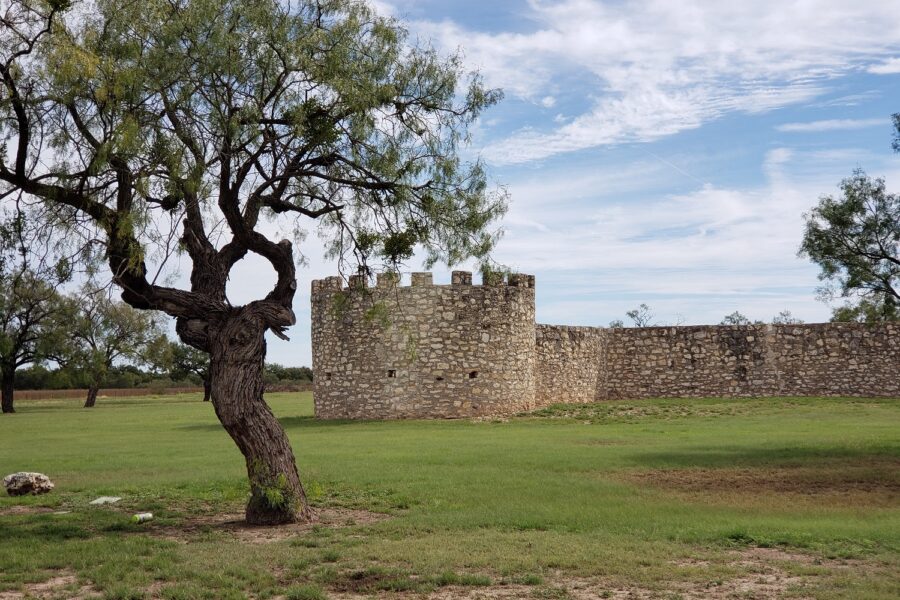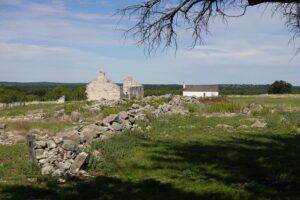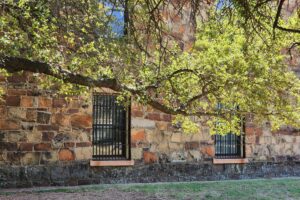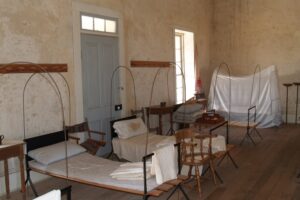Menard
If you look up places to go and things to see in Menard, Trip Advisor lists eleven historic sites. Out of the eleven locations listed, eight of them have one comment, one has two comments. The remaining sites, a Historic Ditch Walk, and the Presidio San Sabá have six and ten comments respectively. Either the visitors to Menard don’t believe in Trip Advisor and leaving comments or Menard is definitely not a tourist destination — unless you are a traveler on the Texas Forts Trail. However, I love exploring small towns anywhere, not just in Texas. So, we ignore our original destination for the morning, the Presidio San Sabá, and instead drive into the heart of this petite country town.
According to my sketchy historical research, in the late 1800s the town of Menard, formerly Menardville, was referred to as sleepy. This beautiful Sunday morning in October 2021, downtown is beyond sleepy — it is in the throes of a very deep slumber. Not a soul stirs as we drive down what appears to be the main street in town, San Sabá Avenue, aka FM 2092.

Repurposed Hotels and a 1904 Church
We turn a corner and pass by Menard Manor, formerly the four-story Bevans Hotel, now a long-term care, and independent living facility for seniors.
With a population of barely 2,000 during the late 1920s when building began on the hotel, I can’t help but wonder, why such a grand hotel so far from the madding crowd? Who lodged here? What drew them to this tiny town so deep in the country?
We drive a bit further and discover where all the people are — at church. There are thirteen churches in Menard and cars line the streets in front of them. I exit our little red Mustang convertible to explore the oldest church here, The Historic 1904 Christian Church, while Michael checks out the sky and a swirling mass of buzzards.



The Ditch
I walk on a worn and torn sidewalk — cement fractured with time — that edges a town park. There is a courthouse within view, a swimming pool, a high school, and a portion of “The Ditch” — an attraction itself. Originally built by the Spanish in the mid-1750s to supply Mission San Saba with water, in 1874 an irrigation company improved the canal to supply water from the San Saba River to 2,000 acres of farm and ranch land in the valley, and also to power grist mills. The Ditch Walk portion of the canal is about a mile in length, with the entire canal spanning ten miles above and below the town.



The Australian Hotel
Returning to the car we continue our exploration, and I ask Michael to stop in front of an old house with a sign out front. I am more than curious and discover it was once an old hotel and boarding house called The Australian Hotel. It was built by William Sanders from Tennessee and Sarah (Hargreaves) Sanders an immigrant from Lancashire, England, via Australia.
As a young man, William caught gold fever and ended up in California. Then, hearing about the gold rush in Australia, he boarded a ship and left the Golden State, arriving in the Land Down Under during the summer of 1853. Will met Sarah and they married two years later. After twenty years, they left Australia and eventually landed in Menardville in the early 1880s. As always, I have to ask — why Menard? And how did they even know it existed?
Will and Sarah sold out to an unnamed individual and left the community in the early 1890s, but the fifteen-room hotel and boarding house, built to resemble hotels in Australia’s Outback, continued on under various ownership.



Mission Santa Cruz de San Sabá
Another sign in front of the former hotel shows all of the points of historical interest in the town and where the marker for the old Spanish Mission Santa Cruz de San Sabá stood. The mission was founded among the Lipan Indians in 1757 by the Franciscan Missionaries. Missions were normally built in close proximity to the presidios for protection; however, in this instance, the missionaries were fearful that being so close to a military fort might upset the Lipan converts to the Christian cause — an obvious mistake in judgment. Barely a year later, the Comanches sacked the mission, left it in total ruins, and killed many of the inhabitants.
It amazes me that this tiny place has so much history, and we haven’t even seen Presidio San Sabá. Visiting this old fort is next on our list.
Stockpen Crossing Park
Before we get to the old fort, Michael makes a right-hand turn into Stockpen Crossing Park. Along with backroads, country towns, and old buildings, I have a fascination for parks and places to picnic. And if there is a road to drive down, Michael always follows his nose. However, driving on this deeply rutted and worn path, I can’t help but wonder about his nose’s judgment. But we make it through, and only have to back up once.
We know the river is beyond the trees, and Michael finally finds a place to park. As soon as I begin walking down the path leading to the water, I see flowers attached to a tree. As I get closer I notice the flowers are attached to a rustic cross with a wooden rosary attached. This breaks my heart, and I remember bouquets in other unlikely places — the rocky coast of Spain, a seldom traveled road deep in the Texas Hills. A tragedy happened here and based on the fresh appearance of the artificial flowers, it is a piece of recent history.
I carefully continue my journey downhill toward the water and Michael. It is peaceful and lovely on this perfect morning in autumn with nary another individual in sight.





Presidio San Sabá
Finally, we make our way toward the ruins and reconstruction of the mid-1700s fort — Presidio San Sabá, located on the banks of the San Saba River. Before visiting the site, we stop at the picnic pavilion adjacent to the parking area and absorb a bit of Texas history. The story of Presidio San Sabá is the story of Texas. It is the story of constant conflicts and opposing interests. It is the story of the Spanish Colonial pursuits of God, glory, gold, and silver, and of the struggle of Native American groups to prevent the foreign invaders from taking their home.



I get it — if strangers came into my yard brandishing weapons and said, “Get out — this is my property now —,” I’d probably take up a bow and arrow or gun or hatchet or whatever I could get my hands on to keep them from taking my home away from me.
The Native Americans won this battle by default because the fort didn’t last. The Spanish dream of riches from silver was never realized, and the presidio was abandoned in 1772. At the time of its occupation, Presidio San Sabá was the lone defender of Spanish authority on an otherwise unoccupied frontier. Both in physical size and the size of its military force, it was the largest and most important military installation in Texas at that time. Being here now, in this distant place, all of it is hard for me to imagine.




Reconstruction x 2
After the Spanish soldiers and their families departed, the fortress quickly fell into ruin, and by 1906 almost all the original stones of the old fort had been used to build homes and businesses in Menard. Reconstruction of the presidio began in 1936 when a crew was hired by the Texas Centennial Commission and paid for by a grant from the Texas Legislature to rebuild the northwest portion of Presidio San Sabá as a tangible reminder of the past. Unfortunately, because this effort began to crumble not long after completion, the old presidio had to be reconstructed three-quarters of a century later. A grant from the Texas Historical Commission helped to rebuild the ruined ruins. Today Menard County is the owner of the Presidio de San Sabá and maintains the grounds.
Looking at and walking through the old fort, I feel the Spaniards and their influence. I can almost imagine I am in Spain, for I have never seen another country so determined to rebuild its ruined castles and towns as the Spanish. It is nice that the United States has followed suit.
Lazy Ladle
My mind is boggled by this small slice — perhaps three square miles — containing all of this Texas History. My little gray cells do not currently have room for any more information at all, so we head to the Lazy Ladle in Menard — the one restaurant around here that is open on a Sunday — and lunch.


Once again, we are in a restaurant with a counter where we place our food order. After making our selection, we find a table tucked in a corner and wait for our lunch to arrive. We pass the time watching farmers, ranchers, church-goers, and a few motorcyclists during their Sunday outing. Everybody seems to know everybody else.
I tried to be thoughtful in my choice of food and ordered a grilled chicken fajita salad, which is extremely tasty. The grilled chicken strips are savory and moist, the vegetables fresh, the avocado perfectly ripe. However, the fries that accompany Michael’s burger are so salty and crisp I keep stealing one at a time and stuffing them into my mouth when he isn’t looking.











Leave a Reply
Your email is safe with us.